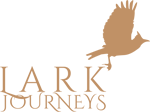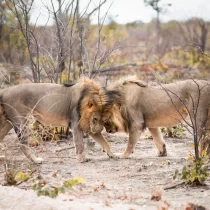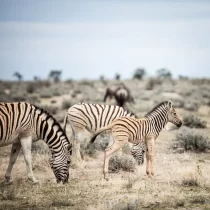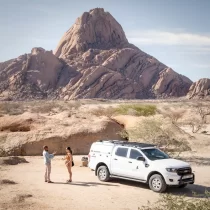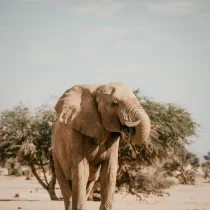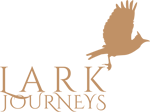Packing Guide for Namibia
Packing Guide for Namibia
Planning a Trip to Namibia?
Whether heading out on a private guided safari or exploring the open roads on a self-drive, packing smart can make the difference between a good and an excellent trip. Here’s a no-nonsense guide to what you need — and what you can happily leave behind.
Layers: Your Best Friend in the Namib Desert
From mid-April to mid-September, it can get cold after dusk — not just “cool breeze” but bring-a-jacket chilly, especially if you’re sitting in an open game drive vehicle at sunrise or sunset. In June, July, and August, temperatures can drop below freezing in parts of the country. A warm fleece, scarf, beanie, gloves, and a windbreaker that blocks wind while bouncing along in an open 4×4 is worth its weight in gold.
In summer, it flips. From October through March, Namibia turns into a furnace by midday, particularly in the north and desert regions. Light-coloured cottons are your best bet. Breathability matters more than fashion — you’ll be sweating by 10 am.
And while we’re on the subject, khaki is not a dress code. You’re not auditioning for a National Geographic special. Neutrals are suitable for game viewing, but nobody’s judging your shirt colour at a waterhole.
Footwear: Don’t Overthink It (But Don’t Burn Your Feet)
You do not need hiking boots unless you’re hiking (like Tok Tokkie Trails or Etendeka Hiking Trail). For most safaris, a pair of good sneakers or closed shoes and comfortable sandals will do just fine.
But if you’re walking on desert sand, be warned — it gets hot enough to burn your feet. Closed shoes are a must for activities like dune walks or desert hikes. Leave the high heels behind.
Namibia Is Casually Cool
One of the joys of travelling here is how laid-back everything is. Shorts and sandals are fine even in the capital or at a fancy lodge. If you’re staying somewhere with linen napkins and a wine list, throw in a smart-casual shirt or a summer dress — not because it’s required, but because you might enjoy the change. Just one. That’s all you’ll need.
Cultural Etiquette: Friendly, But Mind Your Manners
Namibia is a liberal and tolerant country, and visitors are generally welcome no matter where they go. But there’s one thing that absolutely matters here: politeness. Always greet people — whether it’s a shopkeeper, lodge staff, or a passerby. A warm “hello, how are you?” is not optional. Not doing so is considered rude, even if you’re stressed, tired, or in a rush.
Also, if you’re travelling to rural or traditional areas, consider wearing something a little more conservative than you might at the coast or in Windhoek. Nobody’s asking for a big change, but toning down the bare skin, especially in villages, shows respect and that you have made an effort.
Documents and Entry Requirements
- Passport: Must be valid for at least 6 months beyond your travel dates and have at least three blank visa pages.
- Visa Requirements (2025 Update): As of 1 April 2025, citizens of 33 countries (including the UK, USA, and many EU nations) now need a visa to enter Namibia. It can be obtained on arrival at designated ports or in advance via the Namibian eVisa system. The fee is N$1,600 (about €82 / US$88).
- Driver’s Licence + IDP: If you’re self-driving, bring both your domestic Licence and an International Driving Permit if your license is not printed in English. (If your license is in English, you do not require an IDP.)
- Travel Insurance: Don’t skip this. Namibia is remote in many places — medical evacuation coverage is a must.
Safari Gear & Gadgets
- Binoculars – Don’t rely on the guide’s pair. A compact 8×32 is ideal.
- Headlamp or torch – Power cuts or bush camps happen.
- Universal adaptor – Namibia uses the South African Type M plug.
- Power bank – For long drives without charging points.
- SIM card – These can be collected at the airport (which can be slow) or from a few telecommunication shops in Windhoek and other towns.
- Camera gear – Bring the zoom lens. Dust protection and lens cleaner helps, too.
- Dry bag or zip-locks – For dusty days or boat rides in Caprivi.
- Daypack – Handy for carrying water, sunscreen, and a camera on game drives.
Toiletries & Health
- Sunscreen – High SPF, especially for desert trips.
- Lip balm with SPF – Cracked lips are real.
- Moisturiser – The air is dry year-round.
- Insect repellent – Especially for Etosha and Caprivi.
- Basic meds – Include Imodium, painkillers, antihistamines.
- Reusable water bottle – Most lodges have filtered water.
The Unexpected Extras That Make a Difference
- A kikoi or sarong – Shade cloth, towel, impromptu curtain. Incredibly versatile.
- Sports bra – Namibian roads can be very corrugated and bumpy.
- Notebook or journal – This is often a once-in-a-lifetime experience and can be a great way to take a break from all your devices.
- Swimsuit – Many lodges have pools for a midday cool-off.
- Zip-up hoodie or shawl – Great for layering and flights.
- Soft overnight bag – Especially if you’re flying between camps. Many Namibian fly-in safaris have strict luggage limits and don’t allow hard cases.
Things You Can Leave Behind
- Hair dryers (some lodges have them but most of the time it dries in minutes)
- Drones (restricted in national parks and require a permit from the aviation authorities elsewhere)
- Fancy jewellery or anything flashy – not useful and makes you a target
- Too many clothes
Final Tip
Pack light. Namibia’s beauty lies in its rawness, not in dressing up for dinner. Bring the basics, know the seasons, and focus on being comfortable and present. You’re here for the wildlife, the landscapes, the silence — and a suitcase full of gear won’t improve that. But a well-timed windbreaker, a pair of real shoes in the desert, and the right documents? Game changers.

